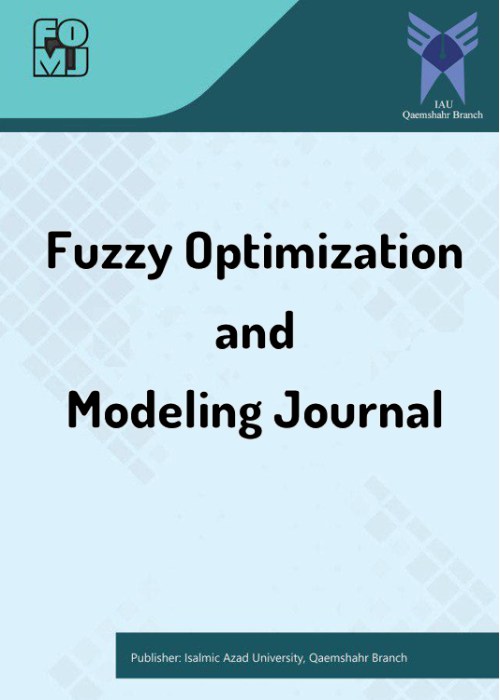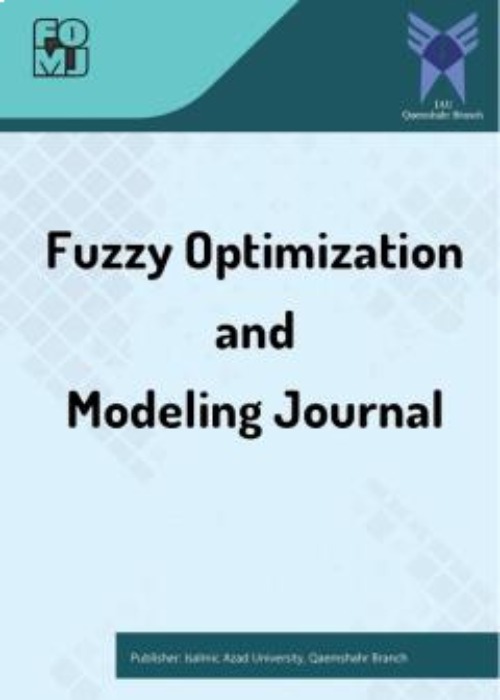فهرست مطالب

Fuzzy Optimzation and Modeling
Volume:3 Issue: 4, Autumn 2022
- تاریخ انتشار: 1401/09/10
- تعداد عناوین: 6
-
-
Pages 1-8Supplier selection (SS) is a process in which companies identify, evaluate, and select suppliers. The MCDM methods are often used for supplier selection in supply chain management. An unlimited number of MCDM techniques, such as analytic hierarchy process (AHP), analytic network process (ANP), the technique of order preference distance to the ideal solution (TOPSIS), etc., have been deployed to solve the supplier selection problems. Though they can manage problem complexity, MCDM techniques cannot deal with problem uncertainty. Hence, they have been combined with the fuzzy set, intuitionistic fuzzy set, etc., to provide more accurate solutions to supplier selection problems. Nonetheless, the future uncertainty related to the environmental changes is ignored in the SS literature. Therefore, we use future scenarios as criteria to select the best supplier in this study. Moreover, we applied a distance measure to rank Type-2 Intuitionistic Fuzzy Set, which is a suitable approach to deal with the vagueness of verbal judgments. A numerical example explains the 5-step proposed approach.Keywords: Uncertainty, Supplier Selection Scenario, intuitionistic fuzzy sets, Distance Measure
-
Pages 9-16
The analysis of financial ratios is one of the methods of examining the state of companies, which expresses the relationships between the items in the financial statements. The study of financial ratios helps us to get a comprehensive and correct understanding of the performance and financial status of companies and to benefit from them when investing and checking the efficiency of companies. Since many current phenomena in finance and the economy are ambiguous, they are treated as if they are clear, so this article, using Neutrosophic, examines the selection of a company for investment using financial ratios in the Neutrosophic environment. Where verbal judgments (qualitatively) are used for decision-making, the proposed approach will perform better than previous approaches. To rank the options in this research, eight financial ratios widely used in investment analysis are considered indicators of the problem. Then, ranking the alternatives is done by defining the ideal option (with the best performance in all indicators) and applying the known criterion of similarity. A numerical example is operated to understand the proposed approach better, and the results are presented.
Keywords: SVNS, Neutrosophic Sets, similarity measure, financial ratio -
Pages 17-31In this paper, by using s-norms, the notion of fuzzy bi-ideals in semirings will be defined and investigated some properties of them. Next prime, strongly prime, semiprime, irreducible, strongly irreducible of them will be introduced and obtained some results about them. Latter, they will be investigated under regular and intra-regular semirings. Finally, they will be characterized under totally ordered by inclusion.Keywords: Semirings, Fuzzy set theory, Norms, anti fuzzy bi-ideals
-
Pages 32-36In this present work, we prove fixed point theorem for contractive mapping F: X → X in fuzzy metric spaces that have a nonempty F− invariant complete subspace , then prove the uniqueness the fixed point in E. Though many theorems in fuzzy metric space in this case, our theorem is a new type of these theorems as it is we proved that a unique fixed point there exists in F− invariant complete subset E in X. Finally, we give an interesting example in complete fuzzy metric space that satisfies in the conditions of our theorem and prove the uniqueness fixed point of F.Keywords: fixed point, Fuzzy metric space, F- invariant
-
Pages 37-50
The present research aimed to identify and analyze effective drivers in the future of crypto fintechs using a fuzzy approach. The research was applied in terms of purpose and had a quantitative methodology. The theoretical population consisted of financial experts in fintechs and blockchain technology. Judgmental sampling was performed based on the expert's expertise. A sample size of 10 was studied. Two quantitative techniques, fuzzy Delphi and DEMATEL, were utilized in the study, and the expert and effect assessment questionnaires, which had desired validity and reliability, were used to collect data. The research had three stages; first, 22 drivers were obtained using the literature review and interviews with experts. Second, the drivers were screened by distributing expert assessment questionnaires and the fuzzy Delphi method. Third, 10 drivers were selected for the final analysis due to the suitable deffuzification number. Such drivers were evaluated by distributing effect assessment questionnaires and the fuzzy DEMATEL technique. The drivers of national regulatory policies, the development of national RegTechs, and the development of smart contracts in the financial industry respectively had the highest net effects. Practical suggestions were extracted based on prior drivers and interviews with focus groups.
Keywords: driver, future, Crypto FinTech, fuzzy decision making -
Pages 51-66A graph structure is a useful tool in solving the combinatorial problems in different areas of computer science and computational intelligence systems. In this paper, we apply the concept of vague sets to graph structures. We introduce certain notions, including vague graph structure (VGS), strong vague graph structure, vague i-cycle, and illustrate these notions by several examples. We study ϕ-complement, self-complement, strong self-complement, totally strong self-complement in vague graph structures, and investigate some of their properties. Finally, an application of vague infuence graph structure is given.Keywords: Vague set, Vague Graph Structure, strong (VGS), ϕ-complement of a VGS


